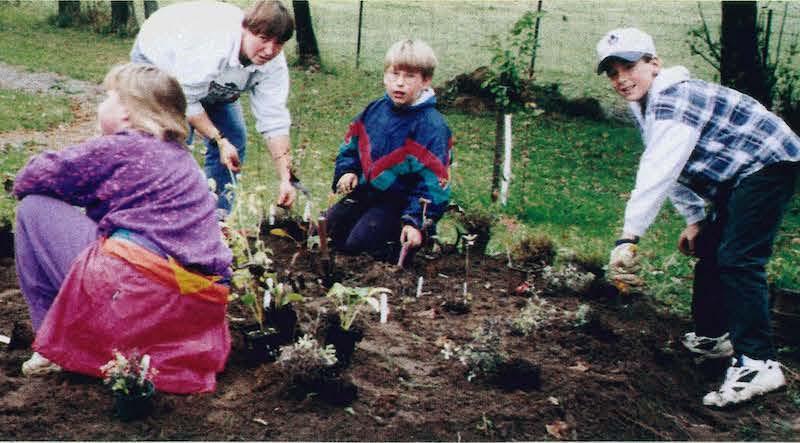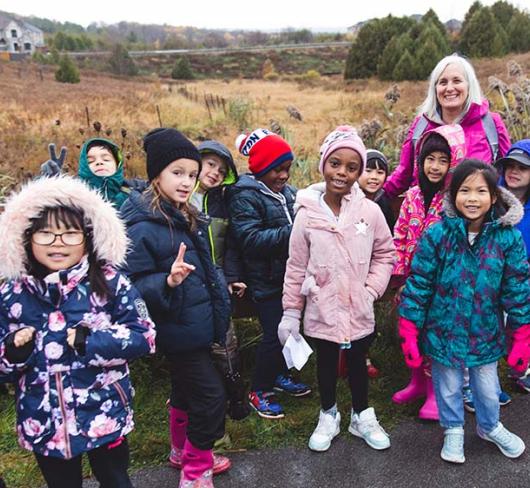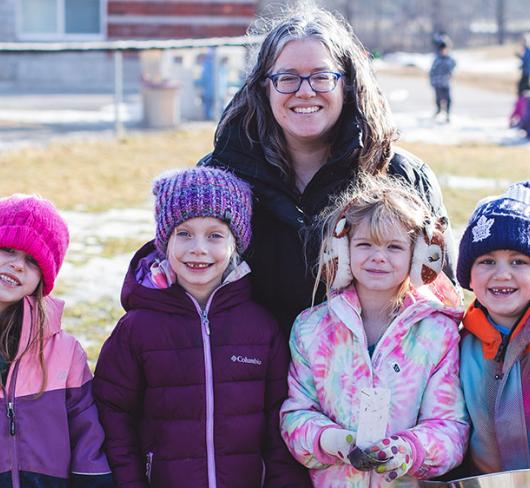
Creating a Learning Ground: A School Yard Restoration Project
There are many schools where the playground equipment is aged and unsafe. This provides an opportunity to implement a restoration program and build a learning ground. If you are inspired by this account of what we accomplished at Millgrove School, Flamborough, the easiest place to start is by contacting Evergreen Learning Grounds. Evergreen keeps a wealth of information on its website and has developed a comprehensive manual and video All Hands in the Dirt: A Guide to Designing and Creating Natural School Grounds.
It began on Earth Day, 1989. We were celebrating by planting a native tree and some shrubs in our school yard, which was almost all grass except for a neglected baseball diamond, a soccer area, a small wooden climber and tarmac. I never enjoyed recess duty. In winter, freezing wind ripped through anyone who attempted a playground game. In summer, there was no place to escape from soccer balls or sit quiedy under a tree. The special needs children used only the paved area. Even with such a large grassy site, the children often found nothing to do but bicker. One day, as I listened to the words of complaint about having nothing ‘fun’ to do, I finally heard what the children were saying.
To enjoy our space to the fullest, we need a place for shelter, for active play, and for small groups to get together.
Teachers who shared my dislike of yard duty began to chat about change. We wanted to reduce the chaos of recess and give students a friendlier environment.
We decided to develop an ecological restoration area in a far corner of the yard — a Carolinian Forest. The experts had informed us that about 80 per cent of the Carolinian Forest, which had grown on our land before the settlers arrived no longer existed. Most of us, sad to say, had no knowledge of the plants, trees or wildlife that had once lived in our climate zone. We needed to learn about Carolinian plants and trees, as well as how to plant and maintain them. Our ideas required funding and support. We would have to involve the principal, the caretaker, students, parents, and the community. It seemed an impossible order.
Somehow, with a bit of information, a pile of enthusiasm, and a generous measure of innovation, the project began. Since none of our staff was a qualified landscape architect or horticultural expert, we sought information elsewhere. Expertise and support flowed in from Evergreen and other environmental groups, as well as from individuals promoting the idea of protecting our environment and restoring the earth.
We developed a plan and students and teachers began researching how to implement it. In the spring of 1990, our first grant of $500.00 arrived from Evergreen. At the time, it seemed a huge amount of money. We used it to buy more native shrubs and plants. The principal set aside a day and everyone in the school, along with a few parents and an energetic, knowledgeable student volunteer from The University of Waterloo, went out to plant, to learn and to begin appreciating our schoolyard. To our amazement, almost every student worked hard, took pride in what they were doing, and enjoyed the day. The curriculum had taken flight out of doors and the learning was experiential and gratifying.
After that first spring planting, we realized we were ready for a long term plan. It was clear that if the students and members of the community were to remain interested in the restoration, they would have to take ownership for the project.
The principal held two school wide assemblies. We grouped students into families, kindergarten to grade 5, and facilitated as they planned their playground. At first, the planners had a great giggle mapping swimming pools, go-carts and even a golf course. Teachers nudged discussions towards activities students could enjoy in a natural environment. When taught how to solve problems in this real life situation, even the youngest students made wise decisions. Their plan was articulated beautifully. They had changed their playground from “what it was” to “what it could be.”
Parents and members of the community helped and, as the playground developed, volunteers contributed plants, trees, time and expertise. Teachers and students learned together. One shy man came at night to plant oak, cucumber magnolia, hickory and other endangered Carolinian species. He was thrilled that the young students would be taking care of his plants.
Since we needed a separate committee concerned with play apparatus, a strong parent group formed to fundraise and eventually purchase equipment chosen by the students. As everyone agreed about the need for sand, the parents designed and built a huge area enclosed with log pieces. On our first “sand day” all the children — even the older ones — shouted out “ooos” and “aaahs” as they rounded the corner from the bus. Instinctively, they ripped off shoes and socks and raced across the playground to “dive in.”
Parents also purchased garden tools, parallel bars, climbers and built a small hill. Teachers organized a half kilometer walking path. These projects were in keeping with the primary focus of the grounds. All monies for the plants came from Evergreen and theTD Canada Trust Friends of the Environment Foundation.
After the five year plan had been designed, assemblies were held to celebrate our accomplishments to date and to revise the plans. The playground parent group stayed strong and worked with the students as well as with community members to continue realizing the plan. Parents initiated “Go for Green Day,” and people arrived with shovels and other equipment to tidy, fix and build on the Learning Grounds. This group is still meeting today, thanks to the dedication of one strongly committed mother.
Almost from the inception of our Learning Grounds, teachers found it easy to relate links to curriculum. Fun fairs came into arithmetic class as students counted profits and made graphs to show progress. Art posters and signs were designed and delivered. Crafts and bake sales augmented reading, writing and technology. The Learning Ground became another classroom and was used as never before. Students were involved in reading, researching, drama, art, science, mathematics, and writing stories, poetry and journals. Physical education was fun and healthy, both in summer and winter. The students made wreaths, did silk screening, studied botany and geography, and decorated the school.
A "learning grounds day festival," devoted entirely to outdoors, enjoyed huge success. Artists gave their time to families of students. Activities included storytelling set to music, tie dying, folk dancing, drumming, art, visiting wetlands, meeting challenges in sand, building bird, bat, and butterfly houses, and lunching with music performed by the senior school band. A drumming group set the yard in motion. Think of it and we did it. Planning, preparing and evaluating students’ work still took time. However, students’ interest, parental appreciation and community involvement made it all worthwhile.
The playground design continued to change and expand. Our plans were coming to fruition. The playground now included small and large picnic tables with benches as well as shrubs to delineate reading or drama areas, a small hill for carpet riding in the snow, a kindergarten garden, a vegetable garden, large trees and a tree nursery. Hopscotch, Kings Court and a huge hundred square were painted on die once unused tarmac. Many large donated shade trees were dedicated to members of the community. There was still plenty of room for baseball and soccer.
The amazing part was that students played and worked digging huge holes, getting soaking wet on watering days and pulling out uninvited plants. We used no pesticides. Adults helped, but much of the work was done by the students. The caretaker and the secretary never complained and were always there to help.
Now there were more special and interesting places to congregate, students gathered away from flying soccer balls or enthusiastic racers. Our “Peace Garden” became a haven for quiet play. The students had planted native trees and berry shrubs along with flowers and herbs to invite butterflies, birds and wildlife to share the space. Every spring, this garden saw a host of tulips — each one lovingly planted and dedicated by students in honour of a person who gave time or life to accomplish peace for the world during times of war. One Remembrance Day, the piper led students and staff to this garden to celebrate peace given to us. To promote harmony on the playground, young students were trained to help others solve their problems without bullying. Playground violence was reduced substantially.
We worked through the terms of four supportive principals, two of whom went on to support restorations at new schools. Two superintendents worked with students on special days. Community members who took evening walks through the grounds commented enthusiastically about the wild garden — even those who had previously opposed “gardening” in school time.
Our Learning Ground became a base for all civic activity. Students worked to become a “Green School.” The fact that each student participated in some way was important to the well being of the school community. Completed environmental tasks gained points for the Green School program and were announced each morning. Vandalism was minimal and the schoolyard was protected and free of litter. The school became involved in an extensive recycling program. Earth Day activities were part of learning. A “Composting Club” and “Garden Club” were formed. Students carefully recorded the daily activities needed to gain points for Green. The day our School was recognized as a Green School by the Learners in Action Program of the SEEDS Foundation, everyone celebrated both the worth of their labour and their understanding of their roles as responsible citizens.
Our small school project — to plant a Carolinian forest restoration — was just the beginning of what turned out to be an extensive and enriching school community experience. We learned about and connected with our own ecology. Students found something “fun” to do. We met our goals and set new ones, creating a living, beautiful park far more desirable than a place filled only with play structures.
This project touched lives and created memories for all who participated. Incidentally, I also met a personal goal. My personal library now includes at least 100 books I bought to enhance and inform the project in various ways. I keep these to share with my grandchildren and others. My garden at home is a now a small Learning Ground in my neighborhood.
Marietta Stonehouse-Kish (retired) taught Primary and Junior grades at Millgrove School, Flamborough.
Reference
Evergreen Learning Grounds www.evergreen.ca. Tel: (416) 596-1495/1-888-426-3138 Federation of Ontario Naturalists, 355 Lesmill Road, Don Mills, ON M3B 2W8. Tel.: 1-800-440-2366. www.ontarionature.org Email: info@ontarionature.org Learners In Action Program, seeds Foundation, Suite 202, 25 St. Michael Street, St. Albert, AB T8N 1C7. www,greenschoois.ca/seeds

